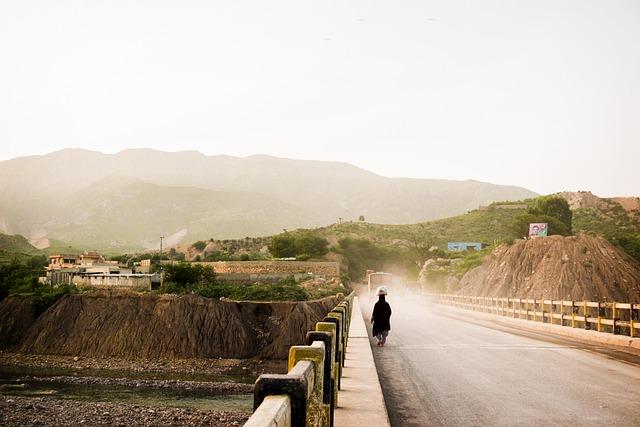As the sun rises over the diverse landscapes of Pakistan, it casts light not only on its rich cultural heritage but also on the evolving narratives of migration that shape its future. In recent years, Pakistan has emerged as a focal point in the global discourse on immigration—an intersection of challenges and opportunities. From the vibrant streets of Karachi to the mountainous terrains of Gilgit-Baltistan, millions are on the move, driven by aspirations for a better life, economic prospects, and the quest for safety. This article aims to unravel the complex tapestry of immigration trends in Pakistan, exploring the myriad factors that compel individuals to seek new horizons, the socio-economic impacts of these movements, and the potential pathways that lie ahead for both migrants and the nation at large. As we delve into this intricate phenomenon, we seek to provide a balanced understanding of the current landscape, illuminating the challenges that arise while also highlighting the opportunities that, if harnessed, could reshape Pakistan’s role on the global stage.
Exploring the Historical Context of Pakistans Immigration Patterns
The historical landscape of immigration patterns in Pakistan reveals a complex interplay of socio-political and economic factors that have shaped its demographic evolution. Over the decades, significant events such as the Partition of 1947, the Afghan War in the 1980s, and the rising tensions in the region have prompted waves of migration both into and out of the country. These events spurred a variety of consequences: from the influx of refugees escaping conflict to skilled individuals seeking opportunities abroad in pursuit of a better life. This continuous ebb and flow has not only altered the population dynamics but has enriched Pakistan’s cultural fabric, bringing diverse traditions and experiences into the mix.
As we delve deeper into the implications of these trends, it becomes clear that challenges coexist alongside opportunities. The presence of a significant diaspora, particularly in countries such as the United States, the United Kingdom, and the United Arab Emirates, has led to remittances playing a crucial role in Pakistan’s economic development. However, issues such as brain drain, where highly skilled professionals leave for better prospects abroad, persist as a pressing concern. Compounding this are the difficulties related to immigration policies and the experiences of undocumented migrants, which warrant an urgent need for comprehensive policy reform. Below is a simplified overview highlighting key immigration waves into Pakistan:
| Time Period | Migration Source | Primary Motives |
|---|---|---|
| 1947-1950 | India | Partition, displacement |
| 1980s | Afghanistan | Soviet War, refuge |
| 2000s-Present | Middle East | Employment, opportunities |

Identifying Key Challenges Facing Pakistani Immigrants Today
The journey of Pakistani immigrants often revolves around navigating a landscape rife with obstacles that can significantly impact their integration and success in their new environments. Prominent among these challenges is cultural adaptation, as immigrants must reconcile their traditional values with the new cultural norms of their host countries. This can lead to feelings of isolation and identity confusion. Furthermore, the barriers of language proficiency pose additional hurdles in both social integration and employment prospects, limiting their ability to fully engage with their communities and secure stable jobs during their early years abroad.
Additionally, economic factors play a crucial role in shaping the immigrant experience. Many Pakistani immigrants face financial difficulties, primarily due to limitations in recognizing foreign qualifications and work experience. This often results in underemployment or a struggle to find jobs that match their skill sets. Legal issues, such as navigating the complexities of immigration laws and securing proper documentation, further exacerbate these challenges. To illustrate this, the table below highlights some key issues faced by Pakistani immigrants and their potential impacts:
| Challenges | Impacts |
|---|---|
| Language Barriers | Lack of job opportunities; social isolation |
| Cultural Adaptation | Identity crisis; difficulty in building relationships |
| Economic Hardships | Underemployment; financial instability |
| Legal Complexities | Increased stress; potential deportation |

Opportunities for Economic Growth Through Strategic Immigration Policies
The evolving landscape of immigration policies may present significant opportunities for Pakistan’s economic growth. By adapting and designing strategic frameworks that prioritize skilled labor migration, Pakistan could harness the global workforce’s potential to fuel its economic ambitions. Key benefits of targeted immigration policies include:
- Boosting Innovation: Attracting skilled professionals can lead to enhanced creativity and innovation within various sectors.
- Filling Labor Gaps: Addressing shortages in critical industries, such as IT and healthcare, can accelerate development and improve service delivery.
- Increased Foreign Investment: A proactive immigration approach can make Pakistan a more attractive destination for international businesses seeking a skilled workforce.
Furthermore, it’s essential to recognize the multiplier effect that immigration can have on local economies. As new migrants settle and establish businesses, they contribute to both job creation and economic diversification. Consider the following potential impacts:
| Impact Area | Potential Outcomes |
|---|---|
| Entrepreneurship | Job creation and economic dynamism from startups initiated by immigrants. |
| Cultural Exchange | Fostering multicultural environments can enhance community engagement and creativity. |
| Tax Revenue | Increased population leading to higher tax contributions supporting public services. |

Fostering Support Systems for Successful Integration and Community Building
Creating a cohesive environment for immigrants in Pakistan requires a multifaceted approach that prioritizes both emotional and practical support. Establishing community centers serves as a vital hub for new residents to access resources and connect with locals. These centers can offer a range of services, including language classes, legal advice, and cultural orientation, aimed at easing the transition into Pakistani society. Collaborative partnerships between governmental bodies and non-profit organizations can foster initiatives that promote awareness and empathy, encouraging native citizens to engage actively with newcomers through mentorship programs and intercultural events.
Furthermore, strengthening social networks can significantly enhance integration efforts. Initiatives such as local volunteer groups or neighborhood associations can act as platforms for shared experiences, allowing immigrants to form bonds with each other and with long-time residents. Regular community meetings and cultural exchange events can help build trust and understanding, creating a sense of belonging. By facilitating these connections, Pakistan can harness the diverse skills and perspectives of its immigrant population, turning challenges into opportunities for progress and enrichment in the broader community. Below is a table illustrating key components of effective support systems:
| Support System Component | Benefits |
|---|---|
| Community Centers | Access to resources and networking opportunities |
| Language Classes | Improved communication and job prospects |
| Mentorship Programs | Guidance from experienced locals |
| Cultural Exchange Events | Strengthened community bonds and mutual understanding |
The Way Forward
As we navigate the intricate landscape of Pakistan’s immigration trends, it becomes evident that this multifaceted issue is emblematic of a larger global narrative. The challenges faced by migrants—the quest for stability, economic opportunity, and safety—are mirrored in the opportunities that these movements present, both for the individuals involved and for Pakistan as a whole. By fostering an environment of understanding, compassion, and proactive policy-making, the nation stands at a critical juncture. Embracing the potential of its diaspora and addressing the pressing issues within its borders can transform challenges into stepping stones for progress. As we look to the future, the journey of Pakistan’s immigration will continue to unfold, demanding our attention and response, ultimately sculpting the fabric of its society. In this ongoing dialogue, we are reminded that immigration is not just a story of movement; it is a convergence of hopes, dreams, and the resilient spirit of humanity.



